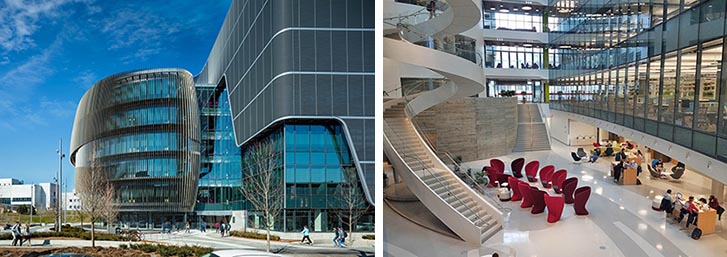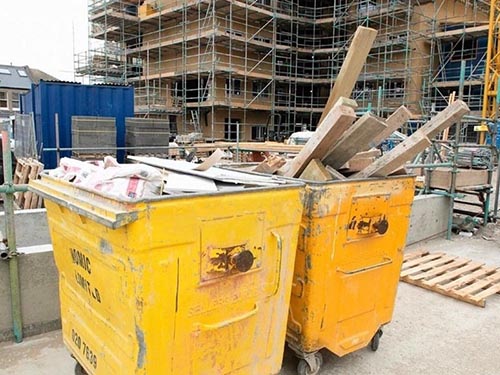Overview
Within This Page
The composition of materials used in a building is a major factor in its lifecycle environmental impact. Whether new or renovated, federal facilities must lead the way in the use of greener materials and processes that do not pollute or unnecessarily contribute to the waste stream, do not adversely affect health, and do not deplete limited natural resources. As the growing global economy expands the demand for raw materials, it is no longer sensible to throw away much of what we consider construction and demolition waste. Using a "cradle-to-cradle" approach, while incorporating appropriate environmental controls, where necessary, the "waste" from one generation can become the "raw material" of the next. When done in an environmentally acceptable manner, the recycling and reuse of construction and demolition (C&D) materials yields numerous benefits, such as conserving raw materials, offsetting impacts associated with the input of virgin materials into construction and renovation of buildings and infrastructure, reduction of landfilling impacts, and conservation of landfill space.
When developing specifications, product descriptions and standards, consider a broad range of environmental factors over a product's life cycle. Such environmental preferability considerations include: optimizing the use of building space and materials, reducing waste at the source, using recycled content (see EPA's Comprehensive Procurement Guideline (CPG) Program) and safer chemical alternatives, energy and water efficiency, and other factors such as life-cycle cost and end-of-life options.

Left: The building form of the Interdisciplinary Science and Engineering Complex in Boston, Massachusetts, is intrinsically linked with high-performance architecture through parametric design and energy modeling to achieve its integrated design. Right: The building's central atrium transfers air from offices to labs for more efficient ventilation and a footprint that optimizes natural light. Photo Credits: Payette
As early as during conceptual design and design-development stages, federal construction/renovation project teams must have a comprehensive, integrated perspective and seek to:
- Salvage and utilize existing facilities, products, and equipment whenever possible, such as historic structures, previous 'brownfield' or 'greyfield' sites, and reconditioned fixtures and furnishings;
- Produce facilities adaptable for different uses during their life cycle incorporating building components that can be disassembled, and reused or recycled;
- Reduce overall material use through optimizing building size and module;
- Evaluate the environmental prefer-ability of products using lifecycle thinking and lifecycle assessment (LCA)
- When new materials are used, maximize their recycled content, especially from a post-consumer perspective;
- Specify materials harvested on a sustained yield basis such as lumber from third-party certified forests;
- Limit the generation of C&D materials, encourage the separation of waste streams, and ensure that reuse and recycling is done in an environmentally acceptable manner during construction, renovation, and demolition processes;
- Eliminate the use of materials that pollute or are toxic during their manufacture, use, and reuse;
- Give preference to locally produced products and other products with low embodied energy content; and
- Encourage success of operational-waste recycling through planning in the design-development phase.
Recommendations
Salvage and Utilize Existing Facilities, Products, and Equipment
- Use reconditioned products and equipment, such as furniture, where economically feasible and resource efficient.
- Evaluate whether existing building components, such as windows or metal door frames, could be incorporated into new construction or renovations. Ensure that salvaged materials meet federal, state and local laws and regulations as well as currently applicable construction codes, in addition to the new facility's security and accessibility requirements.
- If developing a new facility, attempt to clean up and redevelop brownfield, greyfield, or other contaminated, previously used, or impacted sites.
- Employ regionally appropriate design that considers local resources and climate conditions.
- When using existing facilities, products and equipment, work to find ways to reduce potential sources of toxicity (e.g., PCBs in lighting ballasts, paints, caulks and sealants, lead and cadmium in paints, and asbestos) and to improve energy and water efficiency.
Produce flexible facilities with spaces that are adaptable for different uses and utilize building components that can be disassembled and reused or recycled
- Design major systems with differing functions and lifespans to promote disentanglement.
- Design and provide access to the connections that allow disassembly.
- Include adaptable, re-configurable interior systems.
- Deconstruct, re-configure, and reuse interior systems to include demountable partitions, suspended ceiling/lighting systems, raised floors, and infrastructure delivery systems during building renovation or adaptation.
- Utilize building materials with recycled content.
- (See also Design for the Changing Workplace.)
Reduce overall material use through optimizing building size and module*
- Reduce overall building size by optimizing functional relationships between program spaces and circulation, adhering to target utilization rates (number of square feet per person or unit), and designing individual spaces to accommodate multiple functions.
- Design buildings utilizing standard commercially available material sizes, to conserve resources and reduce waste.
*Note: In architecture, "module" is an arbitrary unit adopted to regulate the dimensions, proportions, or construction of the parts of a building. Modules can also serve as the basis for coordinating the dimensions of the various materials and pieces of equipment to be assembled in the course of constructing a building. (Encyclopedia Britannica)
Evaluate Environmental Preferability Using a Life-Cycle Perspective
- Purchase environmentally preferable products as described in EPA's Environmentally Preferable Purchasing (EPP) Program, which promote Federal Government procurement of products and services that have reduced impacts on human health and the environment over their life cycle.
- Use EPA-designated recycled content products to the maximum extent practicable—as required by federal agencies under 42 USC §6962, Resource Conservation and Recovery Act of 1994, Section 6002.
- Within an acceptable category of product, use materials and assemblies with the highest percentage available of post-consumer or post-industrial recycled content.
- In addition to products with recycled content, optimize product durability by purchasing products with extended warranty, upgradeability, spare parts, service information, and mold resistance.
- Consider EPA's Recommendations of environmental performance standards and ecolabels when specifying products.
- The life-cycle of a product includes sourcing of raw materials, manufacturing, packaging, transportation, distribution, retailing, installation, use of the product, and management of the product when it is no longer needed (through reuse, repair, upgrading, recycling, or safe disposal). To capture the benefits of reuse, repair, upgrading and/or recycling, analyze the impact offsets that can be accomplished when the product is used in place of a virgin material in another building or infrastructure.
- Evaluate how materials selection influences the building's overall life-cycle environmental performance and specify materials that can achieve the greatest environmental benefit.
- Where there are certain life-cycle stages or attributes that dominate the opportunity for environmental improvement, those key impact areas (or "hot spots") should be given greater emphasis in a material specification.
- Consider trade-offs among multiple environmental impacts (e.g., global warming, resource depletion, indoor air quality, waste streams) when determining environmental prefer-ability. That is, look at the "big picture" rather than simply shifting problems from one impact to another.
- Employing LCA Tools like ATHENA and BEES can simplify the process and give more credible results.
Limit Generation of C&D Materials and Encourage Separation of Waste Streams and Reuse / Recycling in an Environmentally Acceptable Manner during Construction, Renovation, and Demolition Processes
- During the design phase, require the development and implementation of a Construction Waste Management Plan to maximize the reuse and recycling of C&D materials generated from the project. Consider the following:
- In order to maximize the effectiveness of diversion efforts, (e.g., by ensuring a common understanding of requirements for sorting C&D materials), identify local recycling and salvage operations that can manage site-related C&D materials; and confirm that the facilities are in compliance with state and local regulations, state licensing or registration, and/or third-party independent certification.
- Set targets for waste diversion, from landfills and incinerators, such as salvaging or recycling on-site or off-site, at least 50%, by weight, of the nonhazardous C&D materials generated, excluding land-clearing debris and uses in alternative daily cover.
- In order to maximize the recycling or salvaging of materials, products and components, consider the use of disassembly techniques for a structure, or its portion, planned for demolition; and consider linking the deconstruction project with another current construction or renovation project in order to facilitate reuse of salvaged materials.
- Require submission of a Materials Management Summary report to document diversion results at the conclusion of the project.
- Use products and assemblies that minimize disposable packaging and minimize storage requirements.
- When procuring construction materials and products, select manufacturers and vendors with take-back programs whenever the cost of their products is reasonable, their products are available within a reasonable period of time or distance, and their products meet performance specifications.

Sorting construction waste is an important component of a construction waste management plan. These materials can be repurposed, recycled, and eliminated from landfills. Photo Credit: Creative Commons BY-NC-SA
Specify Materials Harvested on a Sustainable Yield Basis
- Use timber products obtained from sustainably managed forests that are certified through third-party organizations.
- Evaluate the substitution of bio-based materials or products (such as agricultural-fiber sheathing) for inert or non-recycled alternatives.
- Specify rapidly renewable materials that can regenerate within 10 years or less (such as bamboo, cork, wool, and straw).
Eliminate the Use of Materials that Pollute or are Toxic During Their Manufacture, Use, or Reuse
- Consider EPA's Recommendations of environmental performance standards and ecolabels when specifying products.
- Within an acceptable category of product, use materials and assemblies with the lowest level of volatile organic compounds (VOCs) or other chemicals that degrade indoor environmental quality. See WBDG Evaluating and Selecting Green Products and Enhance Indoor Environmental Quality (IEQ).
- Eliminate the use of asbestos, lead, and PCBs in all products and assemblies. See WBDG High-Performance HVAC.
- Eliminate the use of chlorofluorocarbons (CFCs) and hydro-chlorofluorocarbons (HCFCs) as refrigerants in any HVAC systems.
- Evaluate the use of materials and assemblies whose manufacture does not pollute the environment or create toxic conditions for workers. See the following sections of WBDG Secure/Safe—Occupant Safety and Health: Provide Good Indoor Air Quality and Adequate Ventilation and Eliminate Exposure to Hazardous Materials.
- Select paints, coatings, plastics, rubbers, and seals that are free from flame retardants / softeners containing short-chained chlorinated paraffins (SCCPs).
- Select paints, coatings, plastics, rubbers and seals that are free from flame retardants / softeners containing Polybrominated diphenyl ethers (PBDEs) or Hexabromocyclododecane (HBCD).
- Avoid product coatings that contain fluorotelomers which are based on C8 or higher fluorocarbon chemistries.
- Select textiles, paints, printing inks, and paper that are free of benzidine and benzidine-congener-based dyes.
- Use detergents that do not contain Nonylphenol Ethoxylates (NPE) or Alkylphenol Ethoxylates (APE) surfactants, and that are certified by EPA's Safer Choice Program.
- Whenever possible give preference to purchasing products that openly disclose both the substances which are used in the manufacturing process for the product, and also disclose the full list of substances which are contained in the final product.
- Avoid Ground-level Ozone in buildings, which can contribute to health problems for occupants (e.g., respiratory system irritation, increased susceptibility to lung infection, and aggravated asthma) or for local vegetation, and also damage surrounding ecosystems, by minimizing or eliminating the use of equipment powered by any type of fuel that produces air pollution.
Give Preference to Locally Produced Materials with Low Embodied Energy Content
- Evaluate the use of locally produced products in order to stimulate local economies and to reduce transportation burdens and greenhouse gas generation.
- Evaluate the use of materials and assemblies that require minimum "embodied" energy for raw materials acquisition, manufacture, transport, installation, and use.
- Within an acceptable category of product, evaluate the use of materials and assemblies with low embodied energy content.
Encourage Operational Waste Recycling Success through Planning in the Design Phase
- Establish an operational waste management plan in cooperation with building owners in order to encourage recycling.
- During the design and construction phase, designate adequate area(s) for collection of ongoing recyclables. Local salvage, recycling, and collection services should be identified during the design phase in order to maximize effective use of the area(s) designated.
- Investigate providing locations at the project site for organic waste composting.
Related Issues
Durability of Materials
It is important that 'green' products perform just as well as 'standard' products over the course of their expected life cycle; therefore it is essential to develop a durability plan, which informs material and systems decisions assessing potential risk factors and damage functions. Once risks are identified, measures can be taken during building design to address those factors. That process continues in every phase from pre-design to building occupancy. Durability plans consider effects related to moisture, heat, sunlight, insects, material failure, ozone, acid rain, building function and style, and natural disasters. Consider using materials that age gracefully. Often traditional materials used in building construction are easily refinished, repaired, or are partially replaceable, to ensure that a building's potential lifespan is measured in multiple human generations.
Balancing Sustainability and Security/Safety
To ensure that security strategies are appropriately implemented for the desired level of protection, designers are encouraged to conduct threat/vulnerability assessments and risk analysis. To prevent unnecessary use of resources in a project, include only the security measures that are identified by assessment and analysis. Evaluate the cost of comparable security measures before making a final decision. For high-risk and critical facilities, an increased use of materials and products is inevitable. In such cases, designers and builders are encouraged to specify environmentally preferable products to the maximum extent feasible. For example, as part of the Pentagon renovation work after the 9/11 terrorist attack, concrete rubble from damaged parts of the building were crushed into gravel and reused as aggregate under concrete slabs. More
Preferring Bio-based Products
Section 9002 of the Farm Security and Rural Investment Act of 2002 (Public Law 107-171, May 13, 2002) confers Federal purchasing preference to bio-based products on the basis of five criteria: environmental performance, cost performance, bio-based content, technical performance, and availability. In support of this legislation a Federal rule was developed, specifying that the USDA establish a "USDA Certified Bio-based Product" label.
Emerging Issues
New products appear on the market each year claiming to be 'green' yet, sometimes offer little proof to back up such claims. The term 'Greenwashing' describes the marketing of products with unsubstantiated and/or misleading claims about 'green' characteristics. It is challenging for specifiers and purchasers to determine the validity and relevance of environmental claims. Consider EPA's Recommendations of environmental performance standards and ecolabels, and read the UL Greenwashing Report "The Sins of Greenwashing" .
Relevant Codes, Laws, and Standards
Codes and Laws
- DoD Green Procurement Program (GPP)
- Energy Independence and Security Act of 2007
- Energy Policy Act of 2005 (EPACT)
- Executive Order 13834, "Efficient Federal Operations"
- International Green Construction Code (ICC IgCC), International Code Council
Standards
- ANSI/BIFMA e3 Furniture Sustainability Standard
- ASTM E2129 Standard Practice for Data Collection for Sustainability Assessment of Building Products
- ASTM E2921 Standard Practice for Minimum Criteria for Comparing Whole Building Life Cycle Assessments for Use with Building Codes, Standards, and Rating Systems
- Recommendations of Specifications, Standards and Ecolabels for Federal Purchasing, EPA. For these and other standards the federal government is using to meet EO 13693 mandates, go to SFTool: Green Procurement Compilation.
- ISO 14040 Series Life-Cycle Assessment
- P100 Facilities Standards for the Public Buildings Service by the General Services Administration (GSA)
- UFC-1-200-02 High Performance and Sustainable Building Requirements
Additional Resources
Use Green Products
- Federal
- Magazines and E-Newsletters
- The BuildingGreen Report formerly Environmental Building News (EBN)
- Building Green Product Directory
- GreenGuard®
- Other
- Cradle to Cradle Products Program
- GreenSage.com—An online source for green and sustainable building materials and furnishings.
- GreenScreen for Safer Chemicals
- Green Seal
- HPD Collaborative (Health Product Declaration Collaborative™)
- Pharos—Materials evaluation system created by Healthy Building Network
- Sustainable Sources—Green Building Information online green building information
Evaluate Environmental Preferability Using LCA
- BEES (Building for Environmental and Economic Sustainability)—measures the environmental performance of building products by using the life-cycle assessment approach specified in ISO 14000 standards. Developed by NIST.
- EcoCalculator. Developed by The Athena Sustainable Materials Institute.
- Environmental Impact Estimator—lets designers assess the environmental implications of industrial, institutional, office, and both multi-unit and single-family residential designs: new construction or renovation. Developed by The Athena Sustainable Materials Institute.
Maximize the Recycled Content of All New Materials
Specify Materials Harvested on a Sustained Yield Basis
- Forest Stewardship Council United States (FSC)
- GreenBlue
- SCS Global Services
- Sustainable Forestry Initiative
Limit Construction Debris
- Advancing Sustainable Materials Management: Facts and Figures, EPA
- Analysis of the Life Cycle Impacts and Potential for Avoided Impacts Associated with Single-Family Homes—learn how recovered construction and demolition materials from single-family homes help offset environmental impacts associated with the homes. EPA
- Construction and Demolition Debris Recycling, California Department of Resources Recycling and Recovery (CalRecycle)
- Deconstruction Manuals for Construction and Demolition (C&D) Projects—Manuals provide guidance on designing and deconstructing to reduce C&D waste. EPA
- Fact Sheets on the Sustainable Design, Disassembly and Deconstruction of Buildings—Factsheets highlight the innovative approaches, results and environmental and economic benefits from pilot projects. EPA
- Residential Construction Waste Management: A Builder's Field Guide by Peter Yost and Eric Lund. National Association of Home Builders Research Center, January 1997.
- Sustainable Management of Construction and Demolition Materials, EPA
- WasteSpec: Model Specifications for Construction Waste Reduction, Reuse, and Recycling by Triangle J Council of Governments, 1995.
- UFC 1-900-01 Selection of Methods for the Reduction, Reuse and Recycling of Demolition Waste
- Public Works Technical Bulletins, U.S. Army Corps of Engineers:
- U.S. Army Corps of Engineers Sustainable Design and Development Policy Update
Others
- FedCenter.gov—FedCenter, the Federal Facilities Environmental Stewardship and Compliance Assistance Center, is a collaborative effort between the Office of the Federal Environmental Executive (OFEE), the U.S. Army Corps of Engineers Construction Engineering Research Laboratory, and the U.S. EPA Federal Facilities Enforcement Office, a one-stop source of environmental stewardship and compliance assistance information focused solely on the needs of federal government facilities.
- U.S. Green Building Council (USGBC)
Tools
- BEES (Building for Environmental and Economic Sustainability)—measures the environmental performance of building products by using the life-cycle assessment approach specified in ISO 14000 standards. Developed by NIST.
- BIRDS (Building Industry Reporting and Design for Sustainability)—Allows users to compare the sustainability performance of a building type as the energy efficiency design of that building type is increased.
- Sustainable Facilities Tool (SFTool)—This immersive virtual environment addresses all your sustainability planning, designing and procurement needs.
- Tribal Green Building Toolkit—Provides information on how tribes and other communities can prioritize and implement green building codes, policies and practices. This toolkit summarizes priorities identified by the Tribal Green Building Codes Workgroup, a group of tribal and federal leaders working to advance tribal green building.
- U.S. Life-Cycle Inventory (LCI) Database—Created by NREL and partners, this publicly available database allows users to objectively review and compare analysis results that are based on similar data collection and analysis methods.
- Waste Reduction Model (WARM)—WARM calculates and totals life cycle GHG emissions avoided through alternative waste management practices (reduced, recycled, combusted, or composted) in comparison to a baseline scenario (landfilled) for various materials.










